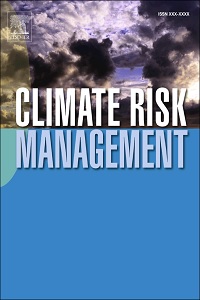Ordenación de tierras
AGROVOC URI:
Sistem informasi geografis untuk pengelolaan sumberdaya alam
Smallholder farmers’ attitudes and determinants of adaptation to climate risks in East Africa
Adapting to climate risks is central to the goal of increasing food security and enhancing resilience of farming systems in East Africa. We examined farmers’ attitudes and assessed determinants of adaptation using data from a random sample of 500 households in Borana, Ethiopia, Nyando, Kenya, Hoima Uganda, and Lushoto, Tanzania. Adaptation was measured using a livelihood-based index that assigned weights to different individual strategies based on their marginal contributions to a household’s livelihood.
Soil physical characteristics under different land use systems and duration on the Colombian savannas = Caractéristiques physiques de sols des savanes de Colombie en fonction de leur mode de mise en valeur et de leur ancienneté
Spatial analysis of soil fertility management using integrated household and GIS data from smallholder Kenyan farms
Although soil fertility is recognized as a primary constraint to agricultural production in developing countries, use of fertilizer in Sub-Saharan Africa is declining. Smallholder farmers still rely heavily on livestock manure for soil fertility management. To explore the determinants of soil fertility management practices, including both the use of cattle manure and inorganic fertilizer, data are used from a sample of 3,330 geo-referenced farm households across Central and Western Kenya. A bivariate probit model is applied to jointly examine the use of the two technologies.
Testing criteria and indicators for the sustainable management of forests: phase 1. Final Report
This report documents the conduct of the first field tests of criteria and indicators (C&I) at the forest management unit level. Interdisciplinary and international teams of five persons conducted tests of five sets of C&I in four countries (Germany, Indonesia, Brazil, and Cote d’Ivoire). This report provides a description of the methods used, a thorough analysis of the findings, a combined generic template of C&I dealing with production forestry, policy, social and ecological issues, based on the groups’ results.
Textes et textes de loi sur la gestion des ressources naturelles au Burkina Faso
La gestion durable des ressources naturelles, notamment dans les pays du Sahel, a toujours soulevé des problèmes dont celui de l’inadaptation des législations nationales y relatives. Le processus d’élaboration et de mise en œuvre de ces législations est à l’image des conditions politiques, socio-économiques et culturelles des pays en question. Le Burkina Faso, pour sa part, a connu plusieurs formes de régimes politiques et, de ce fait, capitalise un certain nombre d’expériences de réformes législatives et réglementaires dans le secteur des forêts et des ressources naturelles.
The CGIAR research program on water, land and ecosystems (WLE)
The CGIAR Research Program on Water, Land and Ecosystems (WLE) combines the resources of 11 CGIAR centers and numerous international, regional and national partners to provide an integrated approach to natural resource management research. This program is led by the International Water Management Institute (IWMI). This presentation provides an overview of the thematic areas that the research is categorized into as well as the focal regions where we work.
The challenge of managing water (and land) in the Ethiopian highlands (Abbay basin)
Technologies for sustainable forest management: challenges for the 21st century. Commonwealth Forestry Congress, Victoria Falls, Zimbabwe, May 1997
Technology will help to address the challenges for sustainable forestry in the 21st century. Some of the challenges will include the shift of production from native forest to plantations in areas of comparative advantage, more efficient processing delinking end-use products from raw wood characteristics, increased demand, better information technologies to support decision makers, and more options for conserving biodiversity.



